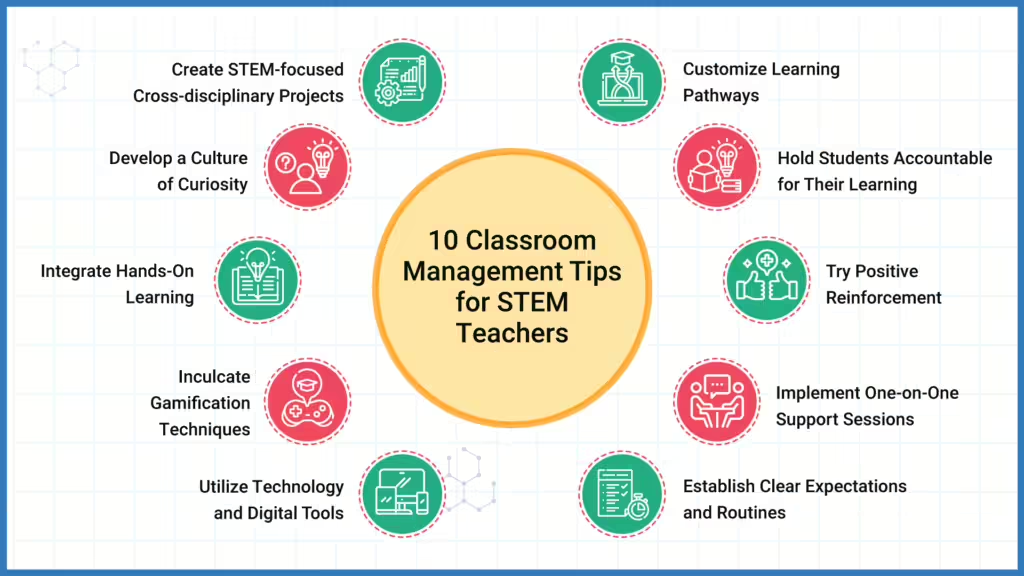
10 Essential Classroom Management Tips for STEM Teachers
Managing a classroom, particularly in STEM education, demands well-thought-out strategies to ensure engagement, participation, and optimal learning outcomes. As high school teachers prepare their classrooms, these classroom management strategies can be game-changers in creating a structured, engaging environment. Here are 10 actionable strategies that help teachers master classroom management and drive student success in STEM subjects.

1. Create STEM-Focused Cross-Disciplinary Projects
Cross-disciplinary projects bring subjects like math, science, and technology together to solve real-world problems. For example, combining STEM education with art can lead students to design machines that create artistic patterns using principles of mechanics. This approach not only enhances students’ creativity but also deepens their understanding of how different fields intersect.
2. Develop a Culture of Curiosity
Curiosity is the cornerstone of STEM education. Encouraging students to ask questions and explore ideas beyond the curriculum fosters a culture of innovation. Implementing the Engineering Design Process (EDP) can structure this curiosity.The Engineering Design Process (EDP) The engineering design process (EDP) is a thinking process used to teach and apply concepts and skills in an integrated manner. For example, engaging students in open-ended problems that require them to “ask, imagine, plan, and create” helps foster a mindset that is critical to STEM success.
3. Integrate Hands-On Learning
Hands-on experiences make STEM education real for students. Practical applications, like solving industry problems or participating in real-life science experiments, bridge the gap between theory and practice. Utilizing tools such as JoVE‘s lab videos adds value by showing real-world applications of theoretical concepts in fields like biology and chemistry, promoting deeper understanding and student engagement.
4. Inculcate Gamification Techniques
Gamification brings excitement into learning by incorporating elements such as leaderboards, badges, and educational games. When students compete in a friendly, collaborative environment, they feel more motivated and engaged. Gamification techniques can turn complex STEM concepts into fun challenges that reward perseverance and innovation.
5. Utilize Technology and Digital Tools
Incorporating digital tools enhances interactive learning in high school. With platforms like JoVE, teachers have access to a video-based science curriculum that simplifies complex concepts through visuals. Whether it’s through simulations, interactive tools, or digital resources, the strategic use of technology not only improves understanding but also keeps students actively involved in the learning process.
6. Customize Learning Pathways
Personalized learning is an effective way to cater to individual student needs within STEM education. Tailoring lesson plans, utilizing digital playlists, or setting differentiated goals allows students to progress at their own pace while still achieving curriculum objectives. JoVE’s customizable features help teachers create playlists and quizzes to tailor learning to the strengths of each student.
7. Hold Students Accountable for Their Learning
Accountability is key in any high school environment. Encouraging students to set personal learning goals and track their progress fosters responsibility for their learning. Integrating self-assessment tools and periodic check-ins ensures that students stay on track with their learning goals and continue to make progress in mastering complex STEM subjects.
8. Implement One-on-One Support Sessions
Personalized support is crucial, especially in challenging STEM education subjects. One-on-one sessions allow teachers to address individual students’ learning needs, ensuring that they grasp complex concepts. These sessions also build strong teacher-student relationships, making students feel supported and more willing to seek help when needed.
9. Try Positive Reinforcement
Positive reinforcement encourages high student engagement by recognizing and rewarding effort and progress. By acknowledging achievements, teachers can help boost students’ confidence and motivation to tackle even the most difficult STEM concepts. A supportive environment that celebrates small wins fosters a love for learning and resilience in students.
10. Establish Clear Expectations and Routines
Structured routines are essential for minimizing disruptions and maintaining focus, particularly in STEM education settings. Clear expectations for behavior and academic performance ensure that students know what is required of them, which reduces confusion and enhances the learning experience. Having routines in place helps maintain a smooth flow during both theoretical lessons and practical lab sessions.
Wrapping Up: Mastering Classroom Management for STEM Success
Incorporating these classroom management strategies will help high school teachers foster a conducive learning environment that promotes student engagement and success in STEM education. Using dynamic tools like JoVE, educators can easily implement these strategies by providing visual, interactive content that aligns with STEM curricula. Start implementing these strategies today to see an improvement in student outcomes, classroom harmony, and overall learning experiences.
These strategies are just the beginning. For additional teacher resources for the classroom, explore how JoVE can further support your teaching efforts with their extensive library of science videos tailored to high school students.
Why wait? Sign up for JoVE today to access thousands of science videos, lab simulations, and more. Enhance your teaching and give your students the dynamic learning experiences they need to thrive in today’s world.
Start now for free and access 20 JoVE science videos to see how they can transform your classroom!